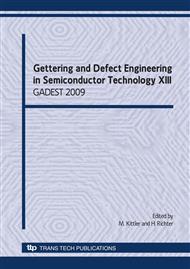p.529
p.535
p.541
p.547
p.555
p.561
p.567
p.573
p.579
Optimization of the Luminescence Properties of Silicon Diodes Produced by Implantation and Annealing
Abstract:
Incorporation of optical components into microelectronic devices will significantly improve their performance. Absence of effective Si-based light emitter hampers such integration. In the present work light emitting Si diodes, fabricated by dopant (boron or phosphorous) implantation and annealing are investigated. Different implantation doses and annealing temperatures were employed. The efficiency of the electroluminescence (EL), obtained from such structures was measured and correlated with the fabrication process parameters. As previously reported, the EL of band-to-band radiative transition in Si is strongly influenced, by the dopant implantation dose, i.e. higher doses usually enhance EL. Our results suggest that the effect is mainly related to the increase of minority carrier lifetime in the substrate. Distinct measurements showed that the higher implantation doses lead longer carrier lifetimes in the samples. The correlation between lifetime and the EL efficiency could be satisfactory explained in the frame of a classical model, considering the carrier-injection dependence of the rates of the three main recombination mechanisms in silicon, i.e. multi-phonon, radiative and Auger recombination. We suppose that the increase in the implantation dose improves minority carrier lifetime due to the gettering of impurity atoms from the substrate material to the highly doped emitter region.
Info:
Periodical:
Pages:
579-584
Citation:
Online since:
October 2009
Keywords:
Price:
Сopyright:
© 2010 Trans Tech Publications Ltd. All Rights Reserved
Share:
Citation:


